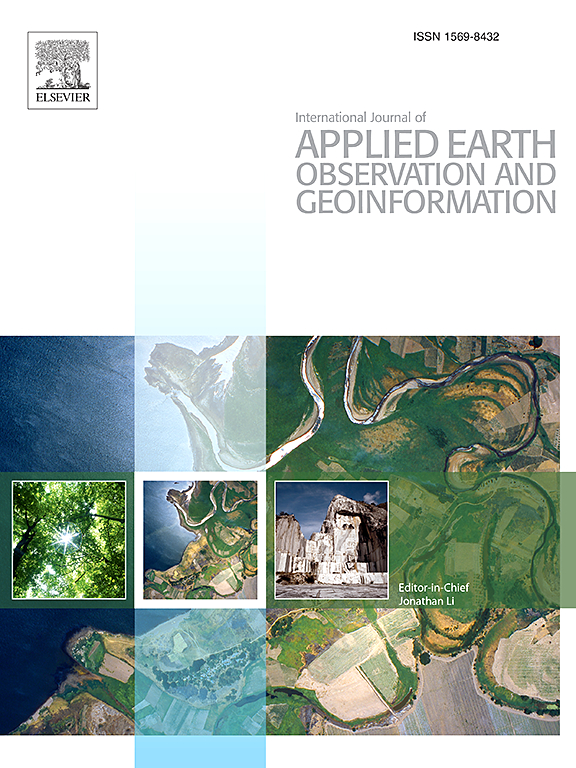利用MT-InSAR和基于迭代stl的沉降比分析对香港地铁沿线施工引起的变形进行时空粒度定量评估
IF 7.6
Q1 REMOTE SENSING
International journal of applied earth observation and geoinformation : ITC journal
Pub Date : 2025-02-01
DOI:10.1016/j.jag.2024.104342
引用次数: 0
摘要
多时相合成孔径雷达干涉测量技术(MT-InSAR)在地铁沿线的地面变形和结构稳定性监测方面具有独特的优势。然而,InSAR可以获得大量复杂的变形点,数百万甚至更多,这给自动识别时间序列中的变形热点带来了挑战。本文提出了一种定量评估mt - insar衍生变形结果的新方法。首先采用黄土(STL)方法进行迭代季节趋势分解,确定从位移时间序列中分离季节分量的最优周期。然后,提出了一种带滚动窗的绝对差值检测器,以量化时间序列内的沉降比,并使变形热点更加明显。为了验证该方法的有效性,采用了2015年6月至2023年11月在香港地下铁路(MTR)上拍摄的468幅Sentinel-1A上升图像。结果表明:99.2%的区域相对稳定,位移速度在−2 mm/年~ 2 mm/年之间;除局部热点地区表现出短期或长期沉降趋势外,84%的区域沉降率保持在0.3以下;研究结果表明,在九龙半岛和港岛线沿线多条地铁线路的交汇处发现了多个变形热点。除了常规MT-InSAR的位移速度外,总体沉降比和年沉降比已被证明是定量评估施工引起变形的有用指标。本文章由计算机程序翻译,如有差异,请以英文原文为准。
Spatiotemporal-grained quantitative assessment of construction-induced deformation along the MTR in Hong Kong using MT-InSAR and iterative STL-based subsidence ratio analysis
Multi-temporal synthetic aperture radar interferometry (MT-InSAR) offers unique advantages in monitoring ground deformation and structural stability along the metro lines. However, a vast number of complex deformation points, millions and even more, can be derived from InSAR making it challenging to identify the deformation hotspot in time series automatically. This paper proposes a novel method for quantitatively assessing the MT-InSAR-derived deformation results. We first introduce an iterative seasonal trend decomposition using loess (STL) method to confirm the optimal period for separating seasonal components from the displacement time series. Then, an absolute differences detector with rolling windows is proposed to quantify the subsidence ratio within the time series and allow deformation hotspots to be more visible. To validate the effectiveness of the proposed method, 468 scenes of Sentinel-1A ascending images from Jun. 2015 to Nov. 2023 over the Hong Kong Mass Transit Railway (MTR) are adopted. The results indicate that 99.2% of areas are relatively stable with the displacement velocity ranging from −2 mm/year to 2 mm/year, and 84% of the study area remained a subsidence ratio below 0.3, except for localized hotspots that exhibited either short or long-term subsidence trends. The findings of this study indicate that multiple deformation hotspots were identified at the intersections of several metro lines in the Kowloon Peninsula and along the Island line. In addition to the displacement velocity from the conventional MT-InSAR, the overall and annual subsidence ratios have been demonstrated to be useful indicators for quantitative assessment of the construction-induced deformation.
求助全文
通过发布文献求助,成功后即可免费获取论文全文。
去求助
来源期刊

International journal of applied earth observation and geoinformation : ITC journal
Global and Planetary Change, Management, Monitoring, Policy and Law, Earth-Surface Processes, Computers in Earth Sciences
CiteScore
12.00
自引率
0.00%
发文量
0
审稿时长
77 days
期刊介绍:
The International Journal of Applied Earth Observation and Geoinformation publishes original papers that utilize earth observation data for natural resource and environmental inventory and management. These data primarily originate from remote sensing platforms, including satellites and aircraft, supplemented by surface and subsurface measurements. Addressing natural resources such as forests, agricultural land, soils, and water, as well as environmental concerns like biodiversity, land degradation, and hazards, the journal explores conceptual and data-driven approaches. It covers geoinformation themes like capturing, databasing, visualization, interpretation, data quality, and spatial uncertainty.
 求助内容:
求助内容: 应助结果提醒方式:
应助结果提醒方式:


